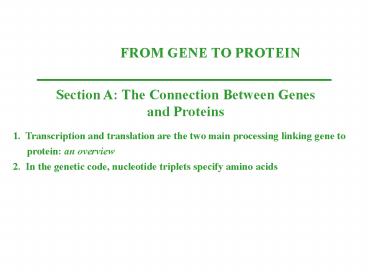Nerve activates contraction PowerPoint PPT Presentation
Title: Nerve activates contraction
1
FROM GENE TO PROTEIN
Section A The Connection Between Genes and
Proteins
1. Transcription and translation are the two
main processing linking gene to protein an
overview 2. In the genetic code, nucleotide
triplets specify amino acids
2
Introduction
- The information content of DNA is in the form of
specific sequences of nucleotides along the DNA
strands. - The DNA inherited by an organism leads to
specific traits by dictating the synthesis of
proteins. - Proteins are the links between genotype and
phenotype. - For example, Mendels dwarf pea plants lack a
functioning copy of the gene that specifies the
synthesis of a key protein, gibberellins. - Gibberellins stimulate the normal elongation of
stems.
3
Transcription and translation are the two main
processes linking gene to protein an overview
- Genes provide the instructions for making
specific proteins. - The bridge between DNA and protein synthesis is
RNA. - RNA is chemically similar to DNA, except that it
contains ribose as its sugar and substitutes the
nitrogenous base uracil for thymine. - An RNA molecules almost always consists of a
single strand.
4
- In DNA or RNA, the four nucleotide monomers act
like the letters of the alphabet to communicate
information. - The specific sequence of hundreds or thousands of
nucleotides in each gene carries the information
for the primary structure of a protein, the
linear order of the 20 possible amino acids. - To get from DNA, written in one chemical
language, to protein, written in another,
requires two major stages, transcription and
translation.
5
- During transcription, a DNA strand provides a
template for the synthesis of a complementary RNA
strand. - This process is used to synthesize any type of
RNA from a DNA template. - Transcription of a gene produces a messenger RNA
(mRNA) molecule. - During translation, the information contained in
the order of nucleotides in mRNA is used to
determine the amino acid sequence of a
polypeptide. - Translation occurs in ribosomes.
- DNA -gt RNA -gt protein.
6
In the genetic code, nucleotide triplets specify
amino acids
- If the genetic code consisted of a single
nucleotide or even pairs of nucleotides per amino
acid, there would not be enough combinations (4
and 16 respectively) to code for all 20 amino
acids. - Triplets of nucleotide bases are the smallest
units of uniform length that can code for all the
amino acids. - In the triplet code, three consecutive bases
specify an amino acid, creating 43 (64) possible
code words. - The genetic instructions for a polypeptide chain
are written in DNA as a series of
three-nucleotide words.
7
- During transcription, one DNA strand, the
template strand, provides a template for ordering
the sequence of nucleotides in an RNA transcript. - The complementary RNA molecule is synthesized
according to base-pairing rules, except that
uracil is the complementary base to adenine. - During translation, blocks of three nucleotides,
codons, are decoded into a sequence of amino
acids.
Fig. 17.3
8
- During translation, the codons are read in the
5-gt3 direction along the mRNA. - Each codon specifies which one of the 20 amino
acids will be incorporated at the corresponding
position along a polypeptide. - Because codons are base triplets, the number of
nucleotides making up a genetic message must be
three times the number of amino acids making up
the protein product. - It would take at least 300 nucleotides to code
for a polypeptide that is 100 amino acids long.
9
- .
- 61 of 64 triplets code for amino acids.
- The codon AUG not only codes for the amino acid
methionine but also indicates the start of
translation. - Three codons do not indicate amino acids but
signal the termination of translation.
Fig. 17.4
10
- To extract the message from the genetic code
requires specifying the correct starting point. - This establishes the reading frame and subsequent
codons are read in groups of three nucleotides. - The cells protein-synthesizing machinery reads
the message as a series of nonoverlapping
three-letter words. - In summary, genetic information is encoded as a
sequence of non-overlapping base triplets, or
codons, each of which is translated into a
specific amino acid during protein synthesis.

